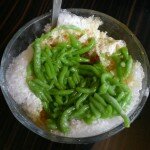Nutrition Information: Cendol
Posted on | May 26, 2010 | No Comments
 Cendol is a sweet, icy dessert found across most parts of Asia. The very simple recipe consists of only five ingredients and can be purchased at road side vendors, hawkers, food courts, coffee shops and restaurants.
Cendol is a sweet, icy dessert found across most parts of Asia. The very simple recipe consists of only five ingredients and can be purchased at road side vendors, hawkers, food courts, coffee shops and restaurants.
It consists of a mound of shaved ice with green chewy pandan-flavoured cendol on top that resemble green worms, coconut milk (santan), a splash of condensed milk, and coconut palm sugar syrup (gula). Add-ins like sago pearls and red beans are optional. Die hard fans will insist that each of these ingredients must be of the highest quality to produce the Cendol that they’ve come to know and love (no watered down, diluted or low quality production variations allowed)
Here is the nutrition information for Cendol:
- Cendol Portion: 368 g
- Energy: 386 Calories
- Protein 6 g
- Carbs: 59
- Fat: 15
- Sodium 195 mg
Don’t be fooled by the large portion of ice! This dessert is quite high in calories, carbohydrates and fat. The portion of coconut and condensed milk is full of sugar and fat (Remember 4 tablespoons of coconut milk has 140 calories and 14g of fat and 2 tablespoons of condensed milk has 130 calories, 22g sugar and high amounts of saturated fat). Topped with the palm syrup and the green cendol the sugar, fat and calories certainly do add up! This dessert is probably best to avoid if you are a diabetic.
Some tips to make this more health conscious: Ask for less coconut and condensed milk and sugar syrup. If you can share the portion with a friend that will help to reduce your calorie intake. And if you plan to have this for dessert, ensure your main meal is a healthy, low calorie option (i.e. choose fish soup or yong tau foo) to balance things out.
Remember – it’s better to waste it than to ‘waist’ it. You can always just taste the Cendol and don’t have to finish the entire bowl. Try to wait at least 20 minutes after eating your main meal to assess if you are actually full (your brain needs time to catch up with your stomach) and always stop eating when you feel 80% full!
Related posts:
Beef Hor Fun is a popular Singaporean...
Lor Mee is a local Singapore dish inspired fro...
Mee Rebus is a local dish that consists of yel...
Black Pepper CrabBlack Pepper Crab is the second m...
Tags: calories in cendol > calories in coconut milk > calories in condensed milk > calories in hawker centre food > calories in hawker food > Calories in Singapore > calories in singapore desserts > calories in singapore food > calories in singapore street food > coconunt milk > condensed milk > icy desserts > is cendol healthy > nutrition information in food > pandan > what is cendol
Comments
Leave a Reply
You must be logged in to post a comment.



